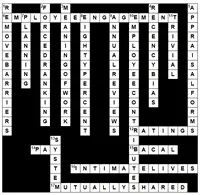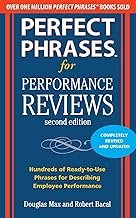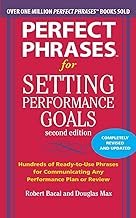Strengths of The MBO Performance Standards Based Method
Standards-based or management-by-objectives approaches have a number of advantages over many of the other methods.
Perhaps the most compelling is that a standards-based approach encourages face-to-face communication between manager and employee to identify the degree to which the employee has achieved the standards or objectives. On balance, with a standards-based approach, the employee is more likely to receive information detailed enough to improve performance— provided that the process is done properly.
If you need help in setting standards (another way of saying "specifying employee goals and objectives", I've written a book just for you. It's called Perfect Phrases for Setting Performance Goals, Second Edition (Perfect Phrases Series) and it's only a ten dollar or so investment available from amazon. You'll find it exceedingly helpful because it provides hundreds of examples of goals, objectives and standards that work well in an MBO system.
The system is flexible, since employees can have different standards of performance, even if their job descrip-tions are similar. Unlike rating systems used across job positions, the standards are completely customizable; in fact, they must be customized.
The system is particularly useful and relatively easy to apply to job tasks that can be measured relatively easily and objectively. It can still be used for complex jobs, but it takes more skill on the part of the manager to use it effectively.
It should be clear by now that the performance standards method involves a lot of upfront work, but less work at the performance review. The result of the extensive work in setting standards (planning performance) is that the employee should leave the standard-setting meeting with a very clear understanding of what he or she is to accomplish during the upcoming period. Not only is that understanding likely in itself to improve performance, but it promotes self-evaluation throughout the year. Employees who know where they need to go are generally able to assess, on their own and throughout the year, whether they are getting there.
Weaknesses
It is extremely hard to write performance standards that are both meaningful and objectively measurable. There’s a saying that goes like this: “It’s easy to measure trivial things, but it’s very hard to measure important things meaningfully.” It applies here. For practical reasons, you can’t have hundreds of standards that apply to an employee’s performance. Perhaps 10 to 20 is the maximum—and even that’s a lot. Identifying which standards to use and writing them in objective ways is an art form and generally requires training for those involved in writing standards. That may mean training both managers and employees.
Some managers complain that the standard-setting process is too time-consuming and difficult. There’s no question that the upfront work involved with this system is much more demanding than, let’s say, for a narrative or rating system, where the upfront work can be almost zero. That may appear as a weakness, but it’s more of a shifting of the work from the performance-review phase to the performance-planning phase.




